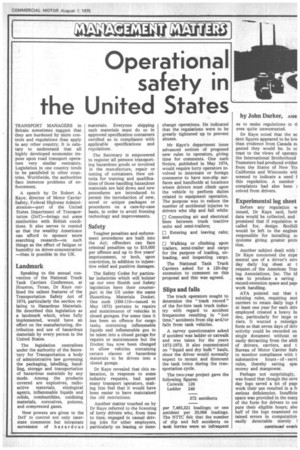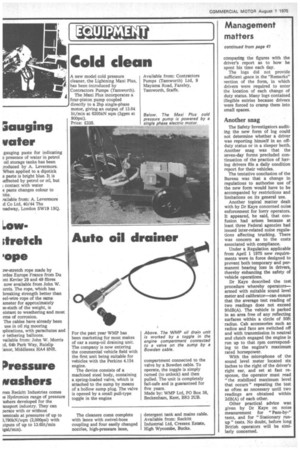Operational safety in the United States
Page 43

Page 44

If you've noticed an error in this article please click here to report it so we can fix it.
by John Darker, AMB'
TRANSPORT MANAGERS in Britain sometimes suggest that they are burdened by more controls and regulations than apply in any other country. It is salutary to understand that all highly developed economies impose upon road transport operators very similar restraints. Legislation in one country tends to be paralleled in other countries. Worldwide, the authorities face immense problems of enforcement.
A speech by Dr Robert A. Kaye, director of Motor Carrier Safety, Federal Highway Administraaion—part of the United States Department of Transportation (Dorn—brings out some similarities with British conditions. It also serves to remind us that the wealthy Americans can afford to sponsor more searching research—on such things as the effect of fatigue or humidity on driver-concentration —than is possible in the UK.
Landmark
Speaking to the annual convention of the National Truck Tank Carriers Conference, at Houston, Texas, Dr Kaye outlined the salient features of the Transportation Safety Act of 1974, particularly the section relating to Hazardous Materials. He described this legislation as a landmark which, when fully implemented, would have an effect on the manufacturing, distribution and use of hazardous materials by every person in the United States.
The legislation centralises under the authority of the Secretary for Transportation a body of administrative law governing the packaging, labelling, handling, storage and transportation of hazardous materials by any mode. Among the products covered are explosives, radioactive materials, etiological agents, inflammable liquids and solids, combustibles, oxidising materials, corrosives, poisons, and compressed gases.
New powers are given to the DoT to control not only interstate commerce but intrastate movement of hazardous materials. Everyone shipping such materials must do so in approved specification containers certified as in compliance with applicable specifications and regulations.
The Secretary is empowered to register all persons transporting hazardous goods or involved in the manufacture, repair or testing of containers. New criteria for training and qualifications of those handling hazardous materials are laid down and new procedures are introduced to permit the introduction of new, novel or unique packages or procedures on a case-by-case basis, in order to avoid freezing technology and improvements.
Safety
Tougher penalties and enforcement procedures are built into the Act; offenders can face criminal penalties up to $10,000 per offence and up to five years' imprisonment, • or both, upon conviction, in addition to injunctive relief and punitive damages.
The Safety Codes for particular industries which will bolster up our own Health and Safety legislation have their counterpart in the US under the name Hazardous Materials Docket. One such (1-1M-110—issued in May 1975) pertains to repairs and maintenance of vehicles in closed garages. For some time it has 'been an offence for cargo tanks containing inflammable liquids and inflammable gas to be taken into a closed garage for repairs or maintenance but the Docket has now been changed to allow vehicles containing certain classes of hazardous materials to he driven into a closed garage.
Dr Kaye revealed that this relaxation, in response to some industry requests, had upset many transport operators, making him feel that it would have been easier to have maintained the old restrictions.
Another matter touched on by Dr Kaye referred to the licensing of lorry drivers who, from time to time, engaged in casual driving jobs for other employers, particularly on leasing or inter
change operations. He indicated that the regulations were to be greatly tightened up to prevent abuses.
Mr Kaye's department issue advanced notices of proposed new rules to operators, giving time for comments. One such Notice, published in May 1974, would require lorry operators involved in interstate or foreign commerce to have non-slip surfaces and handholds at locations where drivers must climb upon the vehicle to perform duties related to equipment operation. The purpose was to reduce the number of accidental injuries to drivers who slip and fall while: E Connecting air and electrical lines between truck tractive units and semi-trailers; • Entering and leaving cabs; and O Walking or climbing upon trailers, semi-trailer and cargo for the purpose of loading, unloading, and inspecting cargo.
The National Tank Truck Carriers asked for a 120-day extension to comment on this proposal and this was agreed.
Slips and falls
The truck operators sought to determine the "track record" of the for-hire tank truck industry with regard to accident frequencies resulting in "lost time," accidents from slip and/or falls from tank vehicles.
A survey questionnaire asked if accident was ladder or catwalk and was taken for the years 1972-1973. It also concentrated on "liquid and dry bulk" hauls, since the driver would normally expect to mount and dismount the tank twice during the transportation cycle.
The two-year project gave the following figures: Catwalk 126 Ladder 246 372 accidents per 7,465,321 loadings; or one accident per 20,068 loadings. The NTTC felt that the number of slip and fall accidents on tank lorries were so infrequent as to make regulations in ti area quite unwarranted.
Dr Kaye noted that the ac dent figures appeared to be low than evidence from Canada se gested they would be. In cc trast to the views of operato the International Brotherhood Teamsters had produced eviden from the States of New Yoi California and Wisconsin whi seemed to indicate a need f this regulation. A number complaints had also been ceived from drivers.
Experimental log sheet
Before any regulation w issued, Dr Kaye said, furtT data would be collected, and promised that if regulation w called for, design flexibili would be left to the enginef responsible for installing ni systems giving greater prot( tion.
Another subject dealt with i Dr Kaye concerned the expe mental use of a driver's sev( day daily log sheet at t request .of the American True ing Associations, Inc. The id was to produce a saving record-retention space and pap work handling.
ATA pointed out that t existing rules, requiring mot carriers to retain daily logs f at least one year for each driv employed created a heavy bt den, particularly for large ct riers. It wanted a redesign form so that seven days of driv activity could be recorded on single document without se ously detracting from the abili of drivers, carriers, and t Bureau of Motor Carrier Safe to monitor compliance with t
substantive hours of servi rules, thereby saving spa( money and manpower.
Perhaps not surprisingly, was found that though the seve day logs saved a lot of pap( work their use resulted in a fc serious deficiencies. Insufficie space was provided in the mare of the form for drivers to coi pute their eligible hours; aho half of the logs examined co tamed errors in computationeasily detectable merely 1 comparing the figures with the driver's report as to how he spent his time each day.
The logs did not provide sufficient space in the "Remarks" section of the form, in which drivers were required to enter the location of each change of duty status. Many logs contained illegible entries because drivers were forced to cramp them into small spaces.
Another snag
The Safety Investigators auditing the new form of log could not determine whether a driver was reporting himself in an offduty status or in a sleeper berth. Another snag was that the seven-day forms precluded continuation of the practice of having drivers file a daily condition report for their vehicles.
The tentative conclusion of the Bureau was that a change in regulations to authorise use of the new form would have to be accompanied by restrictions and limitations on its general use.
Another topical matter dealt with by Dr Kaye concerned noise enforcement for lorry operators. It appeared, he said, that confusion had arisen because at least three Federal agencies had issued inter-related noise regulations affecting trucking. There was concern as to the costs associated with compliance.
Under a Regulation applicable from April 1 1975 new requirements were in force designed to prevent both temporary and permanent hearing loss in drivers, thereby enhancing the safety of vehicle operations.
Dr Kaye described the test procedure whereby operators—. armed with suitable sound level meter and calibrator—can ensure that the average test reading of two readings does not exceed 90dB(A). The vehicle is parked in an area free of any reflecting surfaces within a circle of 50ft radius. Cab accessories such as radios and fans are switched off and with transmission in neutral and clutch engaged the engine is run up to that rpm corresponding to the engine's maximum rated horsepower.
With the microphone of the sound level meter located six inches to the right of the driver's right ear, and set at fast response, the operator must read "the stabilised maximum level that occurs" repeating the test as often as necessary until two readings are obtained within 2dB(A) of each other.
Other practical advice was given by Dr Kaye on noise measurement for " Pass-by-" tests, and for "Stationary runup" tests. No doubt, before long British operators will be similarly concerned.




















































































